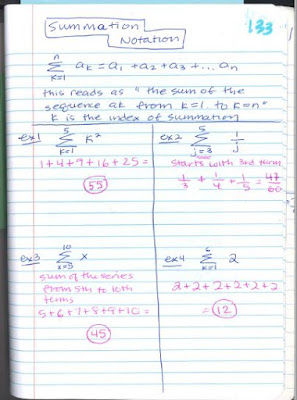http://study.com/academy/lesson/what-is-summation-notation.html
After we spend a day on reviewing sequences we jump right into series. I'd love to cover it all in one 82 minute block. But we start the class by going over homework problems and then I have a POD (problem of the day homework quiz) so we usually have to finish up infinite series on the next day. (More on my PODs and homework policies on an upcoming blog post).
Of course, we start Series by defining them. I use a Frayer diagram:
I have students trim this one a bit so we can glue it into our composition notebook with the orientation shown. That way I have a little room on the bottom for the graphing calculator method of calculating a series. I only let them use this for checking. They have to use other methods to actually calculate the series (as will soon be shown on this blog).
On the page opposite the definition, we do a page on summation notation.
Before I start the formulas for series, I tell the famous Gauss story about adding up the numbers one through 100. If you don't know the story, check out this link (or any other page on the internet that you might when you search this story). I like the link I gave because it references the introduction page for the coolmath lesson on arithmetic series. I LOVE her page and she does a nice job at this link (if you continue to subsequent pages) of developing the formulas. (BTW here is the link for her approach on the whole topic of sequences and series, definitely worth a read through!)
After we do the "trick" young Gauss used I use that to develop the formula. We fill out a foldable on the Arithmetic Series formula.
Lift the flap up and this is what you will see inside this foldable:
On the page opposite, I include some examples for students to work through. This is pretty quick. We don't have to work through them together. They work on them and I walk around and check answers.
There is no cute little story to help my students remember the Geometric Series formula. But fortunately we do have a formula. I introduce that with my foldable.
Lift the foldable flap and you see see the formula and what it's all about.
And again, we have a page of examples on the page opposite. The bouncing ball example is a tricky one!
Finally I do some intro-stuff on the sum of an infinite series. I write two infinite series on the board (the first 4 or 5 terms of each, one with |r|>1 and the other with |r|<1). We talk about what it would look like if we added the terms in the sequence - as many as we can anyhow. Students pretty quickly see that the one with |r|>1 just gets larger and larger. But the one with |r|<1 they are not so sure on. So we work with the graphing calculator way to add series. And we find the sum of the first 10 terms. Then the first 20 terms, then 50, then 100, then 150, etc. Usually by the 50th term we get the sum it converges to. So we talk about what this means. I take the finite Geometric Series formula and ask them what happens when n = infinity? What happens to the formula? This helps them to see how the infinite formula is derived from the finite formula. It's pretty cool to talk through it rather than just give them one more formula to memorize.
Here is my foldable on the formula:
and on the page opposite we have some examples:
Now this school year (2016-2017) this was all I could do with Discrete Math. So the rest of the "overflow" block that I had to use the first bit for infinite series I gave the students a review sheet to practice problems on sequences and series. Then we had a quiz the next day.












casino【WG】top 15【Malaysia】casino games online
ReplyDelete【 에볼루션바카라 JackpotCity Casino】best 윈 조이 포커 시세 casino bonus 승인 전화 없는 꽁 머니 사이트 【 Playtech】gambling for real money 【 Best of Big Dollar 우리계열 Casino】online slots gambling 먹튀 커뮤니티 for real money.